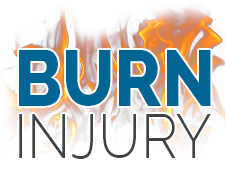Third Degree Burn
A third degree burn is one of the most serious types of burn injuries. Third degree burns are also referred to as full thickness burns. A third degree burn should receive emergency medical attention. This type of burn is more likely to cause permanent scarring or dysfunction of the bodily area than a first degree burn or second degree burn. Third degree burn victims may require extensive rehabilitation, such as physical and psychological therapy after treatment has been administered.
Classifying Third Degree Burn
Third degree burn penetrates both the epidermis and the dermis. The epidermis is the outermost layer of skin, and the dermis is the skin layer underneath. In some cases, third degree burn reaches the victim’s fat, muscle, or bone. The skin affected by a third degree burn may appear stiff. The affected area may appear white, yellow, brown, or black in color. It may feel dry and leathery to the touch. Often, the victim will not feel pain due to damage to the nerve endings in the affected area.
Third Degree Burn Causes
A third degree burn may occur from several sources, including wet and dry heat, chemicals, electricity, friction, and radiation. The most common types of burns are from thermal sources, particularly from exposure to high heat such as fire. Accidents such as workplace explosions may cause third degree burn to employees and other individuals near the explosion.
Third Degree Burn Treatment
A third degree burn should be treated by a qualified medical professional. Smaller third degree burns may take several months to heal. The patient will typically require admission into an intensive care unit for burn injuries. When hospitalized, the patient may receive intravenous (IV) fluids, antibiotics, antibiotic ointments or creams, and nutritional supplements. In cases where a third degree burn affects a large area, the patient may need to undergo skin grafting to close the wound.
Treatment typically depends on a series of factors, such as:
- Burn location
- Burn cause
- Extent of the burn
- The patient’s medical history
- Tolerance for certain medications and treatments
- Opinion or preference of the patient or caregiver
Outcomes and Recovery
In many cases, third degree burn patients will experience long-term or permanent damage to the skin or surrounding areas. During healing, the connective tissues and skin of the affected area may shrink. As a result, the patient may experience stiffness and a decrease in joint movement. In addition to loss of function, the patient may experience scarring and disfigurement in the affected area.
Sources:
Davé, A L. “Third-Degree Burn Following Use of Microwave-Heated Cryogel Pack.” Clinical Pediatrics 32.3 (1993): 191-192. MEDLINE with Full Text. Web. 25 Dec. 2013.
Kwak, Hee Y, and Ji I Kim. “Pulse Oximetry-Induced Third-Degree Burn in Recovery Room.” ANZ Journal of Surgery 79.4 (2009): 307-308. MEDLINE with Full Text. Web. 25 Dec. 2013.
“THIRD-DEGREE BURN.” Post 18 May 2001: 54. Academic OneFile. Web. 25 Dec. 2013.
“Third-Degree Burn.” Time 69.15 (1957): 111. MasterFILE Complete. Web. 25 Dec. 2013.













